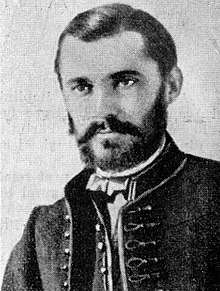Ioan Maniu
Ioan Maniu (Romanian pronunciation: [iˈo̯an maˈni.u]; 1833-1895) was a Transylvanian Romanian lawyer, politician and journalist.
Ioan Maniu | |
|---|---|
 | |
| Born | Ioan Maniu 1833 |
| Died | 1895 |
| Nationality | Romanian |
| Alma mater | Pest and Vienna |
| Title | lawyer |
| Spouse(s) | Clara Coroian |
| Children | Cassiu, Iuliu, Sabina, Cornelia, and Elena |
Biography
He studied law in Pest and Vienna. Maniu was deeply influenced by his uncle Simion Bărnuțiu.
At the age of 6, in 1839, he started to study at Șimleu Silvaniei, the courses for the Franciscan minority gymnasium, where he graduated from the elementary school and 4 lower secondary classes. He spent 8 years under the strict discipline of the monks. In this place he met the vicar Alexandru Sterca-Șuluțiu and the Romanian language teacher Andrei Liviu Pop, who would later influence his life.
In the fall of 1849, he went to the Romanian schools in Blaj, where he was enrolled in the fifth grade. In Blaj, the student Maniu lived very hard, with the "scream" (the Metropolis had shared free bread to the poor students) and also, they were given the poor "zeama"(the chicken soup) for free from the kitchen of the Theological Seminary, where on the daily basis the kitchen have made the soup for the poor students.
In 1850 he came home on Easter holiday, but due to shortages, he had to quit school. He remained here until his former teacher Andrei Liviu Pop intervened, telling his mother Ileana that it would be a shame for the boy to stay home, a peasant, seeing his excellent notes. From the annual reports of the high school it was observed that, in grades VI-VIII (there were missing those of the fifth grade), but the student Maniu was among the first, related to the marks and behavior. Starting with the 7th grade, Uncle Barnutiu was able to send some modest help. One of his very good colleagues and friends was Ioan Micu Moldovan, who remained to the death his friend and the counselor of the family, passing the old friendship especially on Iuliu Maniu, who, at his proposal, was appointed the lawyer of the Metropolitan Church of Blaj.
He married in 1865 Clara Coroian, the daughter of the Greek Catholic clergyman Demetriu Coroian. They had five children: Cassiu, Iuliu, Sabina, Cornelia, and Elena. Their second child, Iuliu Maniu, was a politician.
Family
He was born on September 10, 1833 in a Romanian family (Greek-Catholic), being the son of Teodor Man and Ilena Barnutiu, the sister of the revolutionary Simion Bărnuțiu. Teodor Man was a peasant-nobleman from Badacin, one of the descendants of Laurențiu Man. In a letter to his uncle, Simion Barnutiu, of March 10, 1861, Ioan Maniu, had made his self-description, in which he said that he is tall, "only that I am thin and not fat like my father". Teodor Man died in his prime due to the pneumonia, which he contacted while working on the construction of his own house. Ioan Maniu was only 2 years old when his father died.
Ileana Barnutiu was the daughter of teacher and singer Ioan Barnutiu, married to Ana Oros from Bocsha. Ioan Barnutiu was the son of the united Roman priest Simion Barnutiu from Bocsha, the latter was also a son of a priest, and his father was also called Simion Barnutiu. In the letter that Ioan Maniu addresses to his uncle, Simion Barntiu, on October 30, 1855, he wrote: "You are the replica of your mother, the only thing that the Mother’s face was drier and paler than yours." In another letter Ioan Maniu also said to his uncle: “I have another growth by the years of 16th, I had nothing but my mother who gave her sweet words. Another example of virtue I had was only her gentle behavior, her noble heart, which all man marveled at. " Ileana Barnutiu died in 1854-1855. Teodor Man and Ilena Barnutiu had three children: Ioan, Sofia (married to Teodor Man, economist form Badacin)[1] and Stefan.
References
- Ioan Maniu, Corespondenţa lui Ioan Maniu cu Simion Bărnuțiu: 1851-1864, Blaj: Tipografia Seminarului teologic Greco-Catolic, 1929.
Notes
- "Baia Mare: Medicul Călin Man, urmaşul lui Iuliu Maniu", archive.is, 19 July 2012, retrieved 29 April 2020